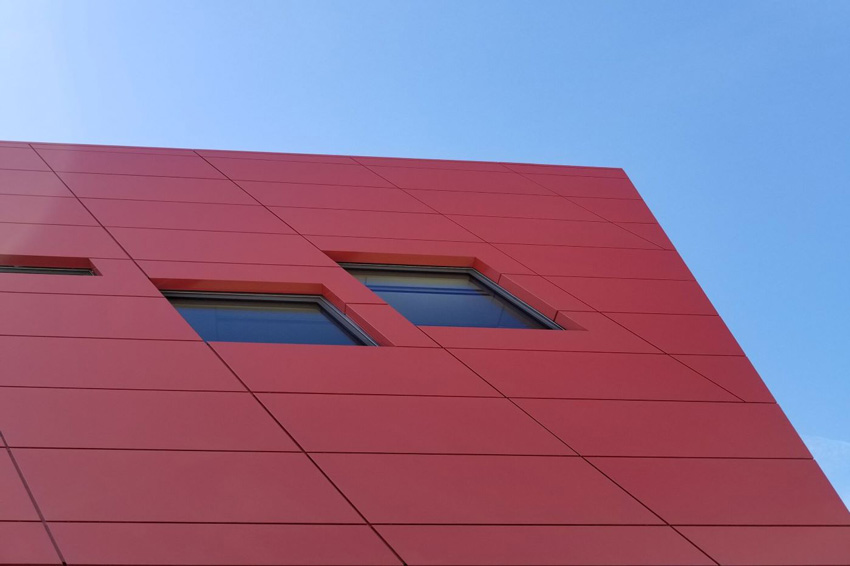Understanding Metal Composite Material, Installation, and Systems
Fire Performance
MCM panels are defined as a metal skins bonded to each side of a solid plastic core. This “composite” panel serves a number of functions when the building is exposed to fire. The metal skins deflect the heat and fire away from the combustible core of the panel. While this is not a permanent condition, and the metal skins eventually melt, when the metal skins are in place, the skins serve to limit both the amount of combustible core available to the fire and the spread of flame.
Concern for fire performance of MCM systems is a major issue in today’s construction world. Several high-rise projects around the world have shown significant flame spread of the exterior cladding when an untested assembly is misapplied on a high-rise structure. Many of today’s MCM panels contain fire-retardant chemistry that limits the amount of available fuel and potential for flame spread. In every reported case of high-rise fires around the world, the MCM panel and installation system have not been manufactured with the newer fire-retardant chemistry, and the overall assembly has not been tested to the rigid standards applicable in North America. In the United States, the NFPA 285 multistory test is a benchmark test for the performance of exterior cladding when exposed to fire. The IBC requires that when MCM is used above 40 feet or when foam plastic insulation is a component of the wall assembly, the MCM cladding systems must successfully meet the NFPA 285 test criteria. These code requirements have existed since the 1990s in various code documents and have successfully limited significant high-rise fires.
Simply put, the cladding systems involved in the significant high-rise fires around the world would not be considered code compliant in North America. It is important to note that there have been no high-rise fire experiences in more than 30 years where the MCM panels with fire-resistant core materials have been used in construction. Compliance with the local building codes is critical to the overall performance of MCM systems.
Manufacturing and The Production Process
The MCM production process is fairly basic regardless of where the product is manufactured. Skin material is bonded to both sides of a solid plastic core. The main challenge is that the different materials do not want to stick to each other (and this only gets worse over time). The other issue is that the manufacturer is taking three individual components that want to move in different directions and trying to make them into a single element that will start off completely flat and stay that way when manufactured, after fabrication, and when exposed to changing temperatures and environmental conditions. However, there are some manufacturing variations that can significantly reduce quality and performance if not implemented correctly.
Typically, in a quality manufacturing process, an extruded core material is produced, followed by the application of metal coil. These components are bonded together through the controlled application of heat, pressure, and tension. The metal skin provides structural stability and a medium that can be finished in a number of colors and finish types. The last stage of the production process is controlled cooling of the bonded sheet to maintain the bond integrity and flatness.
While this process may sound simple, many complex interactions are taking place inside the MCM. The semi-soft malleable core is becoming more rigid as it cools between the two metal skins. The skins are generally aluminum and at a high temperature during the bonding process. Controlled cooling is essential as the process continues. Metal has a high expansion rate and contracts as it cools, making the entire assembly susceptible to moving, twisting, and bowing until the completed panel reaches ambient temperature. Without the controlled addition of heat and pressure, the required bond strength is generally not attained. It is this controlled cooling process that creates a flat panel.
This “continuous process” is vital to ensuring consistency in the quality manufactured products. This is why selecting a quality manufacturer is integral to securing the building envelope against the elements and ensuring the building’s longevity.

Image courtesy of Metal Construction Association
This illustration shows the typical MCM building panel lamination manufacturing line.
The Fabricator's Systems Approach
The second important element in this process is the fabricator’s MCM system, providing a comprehensive solution to building exteriors and envelopes to not only improve the appearance and performance of the facade, but also prevent unwanted air and water intrusion. Undetected moisture intrusion causes costly and catastrophic damage to underlying building materials. Mold and contaminants can not only damage building materials but also create air-quality concerns that can endanger occupants.
While manufacturers can provide superior MCM products, a comprehensive solution will not be successful without a systems approach that includes fabrication and installation. “MCM is a state-of-the-art building material,” says Tom Seitz, executive director of the Metal Construction Association’s (MCA’s) MCM Alliance. “This article is all about understanding the complete MCM package for quality materials, fabrication, and installation. All three of these factors are important for not only a great-looking MCM project but also a quality engineered architectural facade.”
Now that we understand the manufacturing processes and structural performance benefits of MCM, we will outline ways to not only distinguish the differences between MCM manufacturers and MCM fabricators, but highlight characteristics to look for when selecting each for a project.










